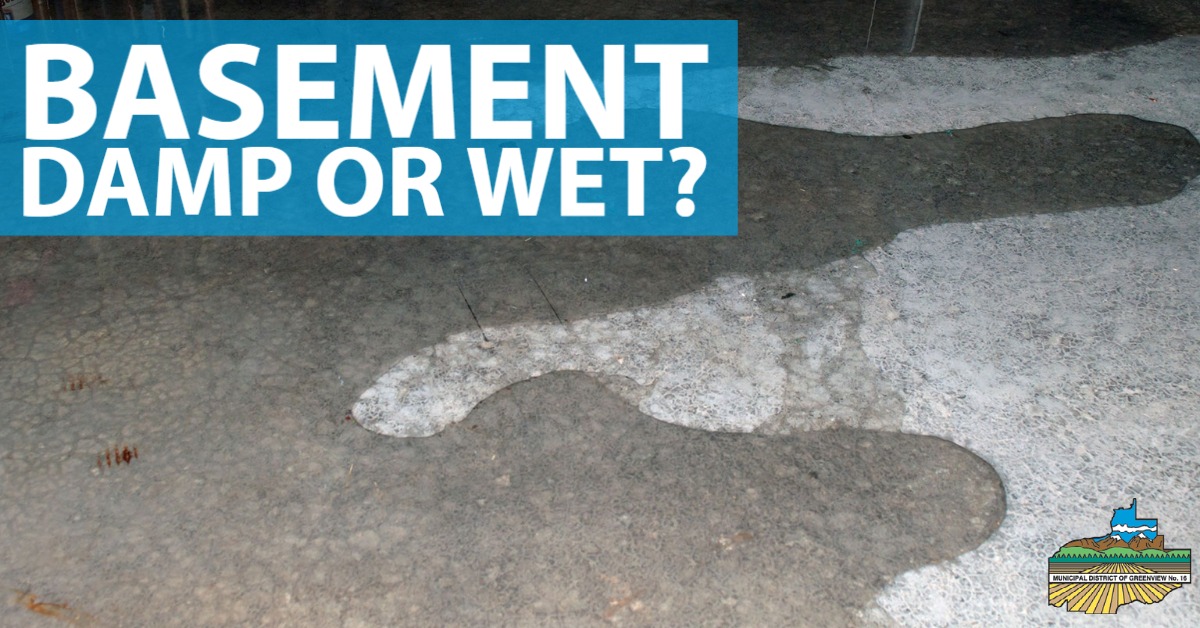Greenview wants to remind residents to check their basements for wet, damp, or flooded conditions.
If your basement is damp or wet, the possible causes are:
- Poor lot drainage
- Overflowing eavestroughs
- Leaking/plugged/missing downspouts or downspouts that are too short.
- A leak in your home’s foundation, basement walls, or basement windows or doors
- Failure of the weeping tile system
- Failure of a Backwater Valve
- Failure of a sump pump.
- A backup (surcharge) of wastewater in the Sanitary Sewer System caused by a blocked connection between your home and the sanitary sewer main in the street, which could be from tree roots, a grease build-up or inappropriate objects. Learn how the Hamlet sewer systems work and how to protect your home from floods.
- A floor drain that prevents weeping tile water from draining.
- Any combination of the above.
In all these scenarios, it is recommended that a licensed plumbing contractor inspect your home’s protective plumbing devices and install missing ones.
Surcharging of the Hamlet sewer main?
If the sewer main (generally under the street) is blocked or damaged, sewage may enter your home due to increased water levels or surcharging in Hamlet’s sewer system. Sewer surcharging may be due to:
- Collapse or other structural defects.
- Blockage by waste and debris.
- Heavy rainstorms or spring runoff.
- Construction activities in the area.
- Grease or tree roots
- Illegal connections of sump pumps or weeping tile into the sanitary service and system
- Roof drains/ eavestrough connected to the sanitary sewer system.
Contacting your insurance company?
- Your insurance company will be able to advise you regarding standard clean-up and claims procedures, along with contractors to contact. Generally,
- Understand your coverage: Review your insurance policy to know what types of flooding damage are covered.
- Document and photograph: Take pictures of the damage and make a list of items to be replaced.
- Keep receipts: Retain receipts for emergency repairs and replacement items.
- Contact your insurance company: Report the flood damage and follow their instructions for filing a claim.
- Cleanup and repairs: Seek advice from your insurance company and consider professional restoration services.
Consult your insurance policy and communicate directly with your provider for personalized guidance on flood damage and insurance claims.
Additional resources: Visit the Insurance Bureau of Canada (IBC) website for more information on home insurance.
How can you help prevent a sewer line backup?
Do not pour grease or cooking oil down the drain. Instead, scrape out or pour cooking oil and grease into a container or plastic bag and dispose of it in your kitchen garbage. Make sure to wipe any residue with a paper towel.
Do not dispose of large absorbent items, like paper towels, diapers, baby wipes or feminine products, down the toilet. These products should be disposed of in your garbage.
Kitchen garburators increase the amount of organic material in the service lines. Depending on the condition of the service line, organic material can stick to the lines and, over time, cause blockages. Compost your organic material instead!
Here’s what you can expect from us:
- Prompt response: If requested, Greenview staff will visit your home as soon as possible.
- Assessment and advice: Our staff will inform you of any identified issues after evaluating the situation. It’s important to note that Greenview is not responsible for repair costs. We recommend contacting your insurance company for further assistance.


